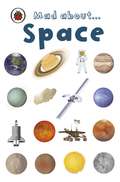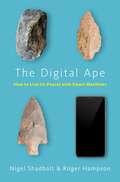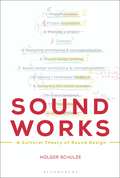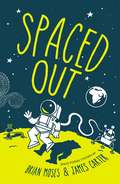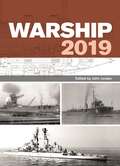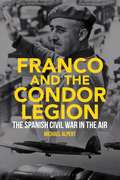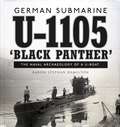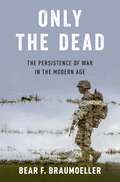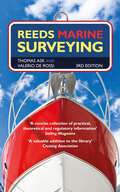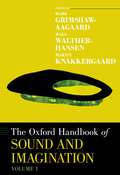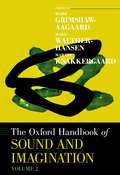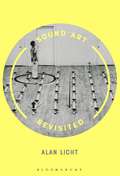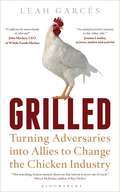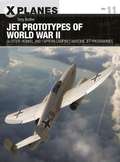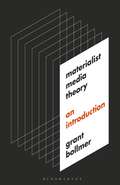- Table View
- List View
Mad About Space
by LadybirdAre you mad about space? From astronauts and asteroids to rockets and robots, this book is packed with fascinating facts and key information for all young space enthusiasts.Ladybird's Mad About series is all about giving its readers all the facts they could possibly need about their favourite subjects. Get ready to impress all your friends with all your new knowledge!
The Climate Question: Natural Cycles, Human Impact, Future Outlook
by Eelco J. RohlingIn 2015, annual average atmospheric carbon dioxide (CO2) levels surpassed a level of 400 parts per million (ppm) for the first time in three million years. This has caused widespread concern among climate scientists, and not least among those that work on natural climate variability in prehistoric times, before humans. These people are known as "past climate" or palaeoclimate researchers, and author Eelco J. Rohling is one of them. The Climate Question offers a background to these concerns in straightforward terms, with examples, and is motivated by Rohling's personal experience in being intensely quizzed about whether modern change is not all just part of a natural cycle, whether nature will not simply resolve the issue for us, or whether it won't be just up to some novel engineering to settle things quickly. This book discusses in straightforward terms why climate changes, how it has changed naturally before the industrial revolution made humans important, and how it has changed since then. It compares the scale and rapidity of variations in pre-industrial times with those since the industrial revolution, infers the extent of humanity's impacts, and looks at what these may lead to in the future. Rohling brings together both data and process understanding of climate change. Finally, the book evaluates what Mother Nature could do to deal with the human impact by itself, and what our options are to lend her a hand.
The Digital Ape: How to Live (in Peace) with Smart Machines
by Sir Nigel Shadbolt Roger HampsonThe smart-machines revolution is reshaping our lives and our societies. Here, Sir Nigel Shadbolt, one of the world's leading authorities on artificial intelligence, and Roger Hampson dispel terror, confusion, and misconception. We are not about to be elbowed aside by a rebel army of super-intelligent robots of our own creation. We were using tools before we became Homo sapiens, and will continue to build and master them, no matter how complicated they become. How we exercise that control--in our private lives, in employment, in politics--and make the best of the wonderful opportunities, will determine our collective future well-being. Chapter by chapter, The Digital Ape outline how our choices and the use and adaptation of the tools we've created can lead to opportunities for the environment (both built and natural), health, and our security. Shadbolt and Hampson are uniquely well-suited to draw on historical precedent and technical know-how to offer a vision of the future that is exciting, rather than nerve-wracking, to contemplate.
Sound Works: A Cultural Theory of Sound Design
by Holger SchulzeWhat is sound design? What is its function in the early 21st century and into the future?Sound Works examines these questions in four parts: Part 1, "Why This Sound?", presents an overview of the modern history of sound design. Part 2 is highly visual and provides a glance onto a sound designer's workbench and the current state of "Sonic Labor." Part 3 uses cultural analysis to explore our contemporary "Living with Sounds." The final and fourth part then proposes a series of anthropological and political interpretations of how “Sound Works” today. This book is not a manual on sound design; it instead argues for a cultural theory of sound design for sound designers and sound artists, for clients who commission a sound design and for researchers in the fields of sound studies, design research, and cultural studies
Rebirding: Rewilding Britain and its Birds (Pelagic Monographs)
by Benedict MacdonaldRebirding takes the long view of Britain’s wildlife decline, from the early taming of our landscape and its long-lost elephants and rhinos, to fenland drainage, the removal of cornerstone species such as wild cattle, horses, beavers and boar – and forward in time to the intensification of our modern landscapes and the collapse of invertebrate populations. It looks at key reasons why species are vanishing, as our landscapes become ever more tamed and less diverse, with wildlife trapped in tiny pockets of habitat. It explores how Britain has, uniquely, relied on modifying farmland, rather than restoring ecosystems, in a failing attempt to halt wildlife decline. The irony is that 94% of Britain is not built upon at all. And with more nature-loving voices than any European country, we should in fact have the best, not the most impoverished, wildlife on our continent. Especially when the rural economics of our game estates, and upland farms, are among the worst in Europe. Britain is blessed with all the space it needs for an epic wildlife recovery. The deer estates of the Scottish Highlands are twice the size of Yellowstone National Park. Snowdonia is larger than the Maasai Mara. The problem in Britain is not a lack of space. It is that our precious space is uniquely wasted – not only for wildlife, but for people’s jobs and rural futures too. Rebirding maps out how we might finally turn things around: rewilding our national parks, restoring natural ecosystems and allowing our wildlife a far richer future. In doing so, an entirely new sector of rural jobs would be created; finally bringing Britain’s dying rural landscapes and failing economies back to life.
Approaches to Videogame Discourse: Lexis, Interaction, Textuality
by Astrid Ensslin Isabel BalteiroThe first significant collection of research in videogame linguistics, Approaches to Videogame Discourse features an international array of scholars in linguistics and communication studies exploring lexis, interaction and textuality in digital games. In the first section, “Lexicology, Localisation and Variation,” chapters cover productive processes surrounding gamer slang (ludolects), creativity and borrowing across languages, as well as industry-, genre-, game- and player-specific issues relating to localization, legal jargon and slang. “Player Interactions” moves on to examine communicative patterns between videogame players, focusing in particular on (un)collaborative language, functions and negotiations of impoliteness and issues of power in player discourse. In the final section, “Beyond the 'Text',” scholars grapple with issues of multimodality, paratextuality and transmediality in videogames in order to develop and enrich multimodal theory, drawing on key concepts from ludonarratology, language ideology, immersion and transmedia studies. With implications for meaningful game design and communication theory, Approaches to Videogame Discourse examines in detail how video games function as means and objects of communication; how they give rise to new vocabularies, textual genres and discourse practices; and how they serve as rich vehicles of ideological signification and social engagement.
Satellite Remote Sensing and the Management of Natural Resources
by Nathalie PettorelliThe ability to anticipate the impacts of global environmental changes on natural resources is fundamental to designing appropriate and optimised adaptation and mitigation strategies. However, this requires the scientific community to have access to reliable, large-scale information on spatio-temporal changes in the distribution of abiotic conditions and on the distribution, structure, composition, and functioning of ecosystems. Satellite remote sensing can provide access to some of this fundamental data by offering repeatable, standardised, and verifiable information that is directly relevant to the monitoring and management of our natural capital. This book demonstrates how ecological knowledge and satellite-based information can be effectively combined to address a wide array of current natural resource management needs. By focusing on concrete applied examples in both the marine and terrestrial realms, it will help pave the way for developing enhanced levels of collaboration between the ecological and remote sensing communities, as well as shaping their future research directions. Satellite Remote Sensing and the Management of Natural Resources is primarily aimed at ecologists and remote sensing specialists, as well as policy makers and practitioners in the fields of conservation biology, biodiversity monitoring, and natural resource management.
Spaced Out: Space poems chosen by Brian Moses and James Carter
by James Carter Brian MosesBlast off into space and explore the galaxies with a constellation of illustrated poems about the sun, moon and stars, black holes and worm holes, asteroids and meteorites, and even weird alien life forms. From shape poems and free verse to rhymes, kennings and haikus, Spaced Out will take you on an intergalactic adventure. Join Brian Moses and James Carter and a wealth of new and established poets to discover your inner space cadet!This starry collection is the perfect way to get children interested in poetry.
Deleuze and the Map-Image: Aesthetics, Information, Code, and Digital Art
by Jakub ZdebikThe map, as it appears in Gilles Deleuze's writings, is a concept guiding the exploration of new territories, no matter how abstract. With the advent of new media and digital technologies, contemporary artists have imagined a panoply of new spaces that put Deleuze's concept to the test. Deleuze's concept of the map bridges the gap between the analog and the digital, information and representation, virtual and actual, canvas and screen and is therefore best suited for the contemporary artistic landscape. Deleuze and the Map-Image explores cartography from philosophical and aesthetic perspectives and argues that the concept of the map is a critical touchstone for contemporary multidisciplinary art. This book is an overview of Deleuze's cartographic thought read through the theories of Sloterdijk, Heidegger, and Virilio and the art criticism of Laura U. Marks, Carolyn L. Kane, and Alexander Galloway, shaping it into a critical tool through which to view the works of cutting edge artists such as Janice Kerbel and Hajra Waheed, who work with digital and analog art. After all, Deleuze did write that a map can be conceived as a work of art, and so herein art is critiqued through cartographic strategies.
Warship 2019
by John JordanFor over 40 years, Warship has been the leading annual resource on the design, development, and deployment of the world's combat ships. Featuring a broad range of articles from a select panel of distinguished international contributors, this latest volume combines original research, new book reviews, warship notes, an image gallery, and much more, maintaining the impressive standards of scholarship and research with which Warship has become synonymous. In the 2019 edition of this celebrated title, articles include Hans Lengerer's exploration of the genesis of the Six-Six Fleet, Michele Cosentino's look at Project 1030, Italy's attempt to create a torpedo-armed attack and ballistic missile submarines, and A D Baker III's drawing feature on the USS Lebanon. Detailed and accurate information is the keynote of all the articles, which are fully supported by plans, data tables and stunning photographs.
Franco and the Condor Legion: The Spanish Civil War in the Air
by Michael AlpertThe Spanish Civil War was fought on land and at sea but also in an age of great interest in air warfare and the rapid development of warplanes. The war in Spain came a turning point in the development of military aircraft and was the arena in which new techniques of air war were rehearsed including high-speed dogfights, attacks on ships, bombing of civilian areas and tactical air-ground cooperation. At the heart of the air war were the Condor Legion, a unit composed of military personnel from Hitler's Germany who fought for Franco's Nationalists in Spain. In this book, Michael Alpert provides the first study in English of the Spanish Civil War in the air. He describes and analyses the intervention of German, Italian and Soviet aircraft in the Spanish conflict, as well as the supply of aircraft in general and the role of volunteer and mercenary airmen. His book provides new perspectives on the air war in Spain, the precedents set for World War II and the possible lessons learnt.
German submarine U-1105 'Black Panther': The naval archaeology of a U-boat
by Aaron Stephan HamiltonNow in its final resting place at the bottom of the Potomac River in Maryland, the U-Boat U-1105 is unique among German World War II submarines. Technologically innovative, it was the only U-Boat to conduct a wartime patrol while equipped with the snorkel, GHG Balkon passive sonar and a rubberized coating known as Alberich designed to reduce its acoustic signature and hide from Allied sonar. After the end of World War II, it was the subject of instense testing and evaluation by the Allies, before finally being sunk to the bottom of the Potomac River.This highly illustrated book uses many new and previously unpublished images to tell the full story of this remarkable U-Boat, evaluating the effectiveness of its late war technologies, document its extensive postwar testing and detail all the features still present on the wreck site today.
British Goats (Shire Library)
by Tiffany FrancisEver wondered why a goat's eyes have rectangular pupils? Or what happened to Thor's goats after they finished pulling his thunderous chariot? Is goat milk and meat a more ethical food choice, and if so, can these industries play an important role in the future of mankind? How about making your own goat's cheese or handspun mohair jumper? Whether you're an aspiring smallholder, cheese fanatic or simply want to know more about our caprine companions, this guide will take you through the fascinating history of goatkeeping in Britain and shed light on one of our most intelligent, curious and mischievous domestic animals. With an increasing demand for goat produce and around 16 different breeds in Britain, explore the cultural rise of goatkeeping from the Stone Age through to the modern day.
Only the Dead: The Persistence of War in the Modern Age
by Bear F. BraumoellerThe idea that war is going out of style has become the conventional wisdom in recent years. But in Only the Dead, award-winning author Bear Braumoeller demonstrates that it shouldn't have. With a rare combination of historical expertise, statistical acumen, and accessible prose, Braumoeller shows that the evidence simply doesn't support the decline-of-war thesis propounded by scholars like Steven Pinker. He argues that the key to understanding trends in warfare lies, not in the spread of humanitarian values, but rather in the formation of international orders--sets of expectations about behavior that allow countries to work in concert, as they did in the Concert of Europe and have done in the postwar Western liberal order. With a nod toward the American sociologist Charles Tilly, who argued that "war made the state and the state made war," Braumoeller shows argues that the same is true of international orders: while they reduce conflict within their borders, they can also clash violently with one another, as the Western and communist orders did throughout the Cold War. Both highly readable and rigorous, Only the Dead offers a realistic assessment of humanity's quest to abolish warfare. While pessimists have been too quick to discount the successes of our attempts to reduce international conflict, optimists are prone to put too much faith in human nature. Reality lies somewhere in between: While the aspirations of humankind to govern its behavior with reason and justice have had shocking success in moderating the harsh dictates of realpolitik, the institutions that we have created to prevent war are unlikely to achieve anything like total success--as evidenced by the multitude of conflicts in recent decades. As the old adage advises us, only the dead have seen the end of war.
Reeds Marine Surveying (Reeds Professional)
by Thomas Ask Valerio De RossiReeds Marine Surveying is aimed at students of marine surveying, professional marine surveyors, boatyard operators and technically-minded boat owners, and covers the latest marine surveying technology, including analysis of the mechanical behaviour of materials, failure analysis, stress concentration, fatigue and fracture, corrosion, wood-damaging organisms, polymer chemistry, and the composition and characteristics of common plastics, metal, alloys and composite materials. This new edition expands its scope to include coverage of surveying topics relevant to ships and class surveying and includes more examples of common problems and the practical elements of surveying, as well as be updated throughout in line with technological developments, guidelines and best practice. Reeds Marine Surveying has been in print for nearly twenty years and excellently serves the community of marine surveyors by providing technically robust presentations of this discipline. It extends the inquiry of inspection and safety beyond anecdote and into foundation principles and technologies.
The Oxford Handbook of Sound and Imagination, Volume 1 (Oxford Handbooks)
Whether social, cultural, or individual, the act of imagination always derives from a pre-existing context. For example, we can conjure an alien's scream from previously heard wildlife recordings or mentally rehearse a piece of music while waiting for a train. This process is no less true for the role of imagination in sonic events and artifacts. Many existing works on sonic imagination tend to discuss musical imagination through terms like compositional creativity or performance technique. In this two-volume Handbook, contributors shift the focus of imagination away from the visual by addressing the topic of sonic imagination and expanding the field beyond musical compositional creativity and performance technique into other aural arenas where the imagination holds similar power. Topics covered include auditory imagery and the neurology of sonic imagination; aural hallucination and illusion; use of metaphor in the recording studio; the projection of acoustic imagination in architectural design; and the design of sound artifacts for cinema and computer games.
The Oxford Handbook of Sound and Imagination, Volume 2 (Oxford Handbooks)
Whether social, cultural, or individual, the act of imagination always derives from a pre-existing context. For example, we can conjure an alien's scream from previously heard wildlife recordings or mentally rehearse a piece of music while waiting for a train. This process is no less true for the role of imagination in sonic events and artifacts. Many existing works on sonic imagination tend to discuss musical imagination through terms like compositional creativity or performance technique. In this two-volume Handbook, contributors shift the focus of imagination away from the visual by addressing the topic of sonic imagination and expanding the field beyond musical compositional creativity and performance technique into other aural arenas where the imagination holds similar power. Topics covered include auditory imagery and the neurology of sonic imagination; aural hallucination and illusion; use of metaphor in the recording studio; the projection of acoustic imagination in architectural design; and the design of sound artifacts for cinema and computer games.
Sound Art Revisited
by Alan LichtThe first edition of Sound Art Revisited (published as Sound Art: Beyond Music, Between Categories) served as a groundbreaking work toward defining this emerging field, and this fully updated volume significantly expands the story to include current research since the book's initial release. Viewed through a lens of music and art histories rather than philosophical theory, it covers dozens of artists and works not found in any other book on the subject. Locating sound art's roots across the centuries from spatialized church music to the technological developments of radio, sound recording, and the telephone, the book traces the evolution of sound installations and sound sculpture, the rise of sound art exhibitions and galleries, and finally looks at the critical cross-pollination that marks some of the most important and challenging art with and about sound being produced today.
Tribology on the Small Scale: A Modern Textbook on Friction, Lubrication, and Wear (Oxford Graduate Texts)
by C. Mathew Mate Robert W. CarpickFriction, lubrication, adhesion, and wear are prevalent physical phenomena in everyday life and in many key technologies. This book incorporates a bottom-up approach to friction, lubrication, and wear into a versatile textbook on tribology. This is done by focusing on how these tribological phenomena occur on the small scale — the atomic to the micrometer scale — a field often called nanotribology. The book covers the microscopic origins of the common tribological concepts of roughness, elasticity, plasticity, friction coefficients, and wear coefficients. Some macroscale concepts (like elasticity) scale down well to the micro- and atomic-scale, while other macroscale concepts (like hydrodynamic lubrication) do not. In addition, this book also has chapters on topics not typically found in tribology texts: surface energy, surface forces, lubrication in confined spaces, and the atomistic origins of friction and wear. These chapters cover tribological concepts that become increasingly important at the small scale: capillary condensation, disjoining pressure, contact electrification, molecular slippage at interfaces, atomic scale stick-slip, and atomic bond breaking. Throughout the book, numerous examples are provided that show how a nanoscale understanding of tribological phenomena is essential to the proper engineering of important modern technologies such as MEMS, disk drives, and nanoimprinting. For the second edition, all the chapters have been revised and updated to incorporate the most recent advancements in nanoscale tribology. Another important enhancement to the second edition is the addition of problem sets at the end of each chapter.
Grilled: Turning Adversaries into Allies to Change the Chicken Industry
by Leah Garcés'An animal activist's journey to the "other side"' Joanna LumleyThis is the story of what happens when we cross enemy lines to look for solutions.Leah Garcés has dedicated her career to fighting for the rights of the animals that end up on our plates. As President of the non-profit group Mercy for Animals and former US Executive Director of Compassion in World Farming, she has led the fight against the sprawling chicken industry that raises billions of birds in cruel conditions – all to satisfy our appetite for meat.Grilled is Leah's story of working alongside the food and farming industry for animal welfare and ethical food. Instead of fighting and protesting and shaming – approaches that simply haven't worked previously – Garcés has instead tried to find common ground with producers. She has worked alongside owners of the megafarms, befriending them, having frank conversations with them, and ultimately encouraging change through dialogue and discussion. Leah is helping to directly improve the lives of millions of farm animals, and pushing alternatives such as plant-based substitutes and lab-grown meats to the top of the agenda, with some of the mega-farm conglomerates joining forces with her to explore these avenues.When she started her journey, Leah Garcés did not have much empathy to spare for the contract chicken farmer –until she actually met one and tried to understand the difficulties they faced. This is the story of giving in to discomfort for the sake of progress. It's a story of the power of human connection, and what happens when we practice empathy toward our enemies.
Cryptoassets: Legal, Regulatory, and Monetary Perspectives
Cryptoassets represent one of the most high profile financial products in the world, and fastest growing financial products in history. From Bitcoin, Etherium and Ripple's XRP-so called "utility tokens" used to access financial services-to initial coin offerings that in 2017 rivalled venture capital in money raised for startups, with an estimated $5.6 billion (USD) raised worldwide across 435 ICOs. All the while, technologists have hailed the underlying blockchain technology for these assets as potentially game changing applications for financial payments and record-keeping. At the same time, cryptoassets have produced considerable controversy. Many have turned out to be lacklustre investments for investors. Others, especially ICOs, have also attracted noticeable fraud, failing firms, and alarming lapses in information-sharing with investors. Consequently, many commentators around the world have pressed that ICO tokens be considered securities, and that concomitant registration and disclosure requirements attach to their sales to the public. This volume assembles an impressive group of scholars, businesspersons and regulators to collectively write on cryptoassets. This volume represents perspectives from across the regulatory ecosystem, and includes technologists, venture capitalists, scholars, and practitioners in securities law and central banking.
The Art of Innovation: From Enlightenment to Dark Matter
by Ian Blatchford Tilly Blyth------------------------------------------------------------------------------------Based on the landmark Radio 4 series, and Science Museum exhibition, this illustrated modern history of the connections between science and art reveals a new perspective on what that relationship has contributed to the world around us. Throughout history, artists and scientists have been driven by curiosity and the desire to experiment. Both have wanted to make sense of the world around them, often to change it, sometimes working closely together, certainly taking inspiration from each other’s disciplines. The relationship between the two has traditionally been perceived as one of love and hate, fascination and revulsion, symbiotic but antagonistic. But art is crucial to helping us understand our science legacy and science is well served by applying an artistic lens. How exactly has the ingenuity of science and technology been incorporated into artistic expression? And how has creative practice, in turn, stimulated innovation and technological change?The Art of Innovation is a history of the past 250 years viewed through the disciplines of art and science. Through fascinating stories that explore the sometimes unexpected relationships between famous artworks and significant scientific and technological objects – from Constable’s cloudscapes and the chemist who first measured changes in air pressure, to the introduction of photography and the representation of natural history in print – it offers a new way of seeing, studying and interpreting the extraordinary world around us.
Jet Prototypes of World War II: Gloster, Heinkel, and Caproni Campini's wartime jet programmes (X-Planes)
by Tony ButtlerWhile World War II raged, pioneering aircraft and engine designers were busy developing the world's first practical jet-powered research aircraft to test and prove the new technology. This book examines the aircraft that paved the way for Germany's Me 262 and Britain's Meteor - the world's first jet fighters. Throughout the war, Germany, Italy and Britain engaged in top-secret jet programmes as they raced to develop the airpower of the future. Various experimental aircraft were trialled in order to achieve the goal of producing an effective engine and fighter that could harness the potential of the jet power. These included the German Heinkel He 178 research aircraft and Heinkel He 280 jet fighter prototype, the famed British E.28/39 research aircraft built by Gloster Aircraft as well as the stillborn E.5/42 fighter and E.1/44 Ace fighter prototype, and finally the remarkable Italian Caproni-Campini N.1/CC 2 research aircraft.Illustrated throughout with full-colour artwork and rare photographs, this fascinating study examines the fore-runners to the military jet age.
Materialist Media Theory: An Introduction
by Grant BollmerOur technologies rely on an ever-expanding infrastructure of wires, routers, servers, and hard drives-a proliferation of devices that reshape human interaction and experience prior to conscious knowledge. Understanding these technologies requires an approach that foregrounds media as an agent that collaborates in the production of the world beyond content or representation. Materialist Media Theory provides an accessible, synthetic account of the cutting edge of the theoretical humanities, examining a range of approaches to media's physical, infrastructural role in shaping culture, space, time, cognition, and life itself. More than a mere introduction, Materialist Media Theory provides a critical intervention into matter and media, of interest to students and researchers in media studies, communication, cultural studies, visual culture, and beyond. Media determine our reality, and any politics of media must begin by foregrounding the media's materiality.
Reeds Introductions: Principles of Earth Observation for Marine Engineering Applications (Reeds Professional)
by Christopher LaversReeds Introductions: Principles of Earth Observation for Marine Engineering Applications covers the fundamental earth-observation concepts that underpin all space-based terrestrial and maritime remote sensing methods. Satellite-based earth observation provides key weather and environmental information to all nations, including key maritime users such as navy, coastguard and merchant vessels. The application and understanding of electromagnetic wave-based devices and sensors is an established merchant sea service requirement, found in the Standards in Training and Certification in Watchkeeping (STCW95) qualification and various Maritime Coastguard Agency exams. It is vital that maritime and land-based users have a basic understanding of the concepts upon which these essential earth-observation systems now operate.The book is written as simply as possible to support the growing numbers of overseas students for whom English is not their first language. It provides a firm foundation prior to reading and studying of the Reeds Marine Engineering series, and is complementary to other volumes in the Introductions series. Maritime and land-based students and scientists having read this easy-to-read volume will be better prepared for more in-depth study.
